by Francine Finck
2nd to 22nd November 2019
Report made during a study visit on the practices developed by traditional healers in certain African therapeutic communities in the Casamance forest. This work was made possible thanks to the recommendations of Professor Colomb, one of the pioneers in social psychiatry and founder of the “School of Dakar”, who was nicknamed “the great white wizard” in Africa.
During a study tour for their thesis in medicine, Francine Finck and her sister Marie Odile reached the village of Kenia, Senegal, in June 1980, with a letter of recommendation in hand to study with Professor Collomb, the father of ethnopsychiatry. Unfortunately, he had passed away just a few months earlier.
This French doctor was born in 1913. After a long career in Africa and Indochina, he arrived in Dakar in 1958, where he founded a school of psychiatry at the Fann Hospital. Its key idea – at the antipodes of colonial psychiatry – was to not cut the patients off from their roots, thus respecting the culture and social context of each. In 1972, he created the village of Kenia based on these same principles. In Africa, where family ties and interpersonal relationships are so important that they form the basis of social functioning, and where insanity is in itself a factor of exclusion, the village allows patients to live traditionally.
The letter for Professor Collomb acted as a pass, opening up the doors of these very closed places to the two sisters. They were received with open arms; a patient told them: “I dreamed of you last night”; they were given a hut. This welcome allowed them to live a unique experience: daily contact with patients, their families, and caregivers.
During their stay, they went to a second psychiatric village in Casamance: Mawa. On arrival, after a trip sown with strange incidents, breakdowns, ailment, etc., the reception was less warm than in Kenia…
Health center for the mentally ill and also prayer and meditation space for the prophet’s disciples, Mawa was founded in 1953 by Cheikh Mamadou Sane, a marabout from Gambia. In a dream, he was entrusted with the mission to go look for a big silk-cotton tree and build the village around it.
Social life here too plays a fundamental role, and therapies are traditional, based on the interpretation of dreams, the presence of spirits and the use of plants, especially trees. What differentiates Mawa from Kenia – where psychotropic drugs are used – is religion: there is a mosque and a Koranic school. Therapy is reinterpreted through Islam.
Like in Kenia, Francine photographed healers, patients and their environment.
When she left, she took with her the photographic films; these impressions have now reappeared, forty years later, flawlessly. For her, this experience created a very strong link with the African continent and her vision of the world.
Mawa and Kenia still exist today.
Dominique Jacques 2019
